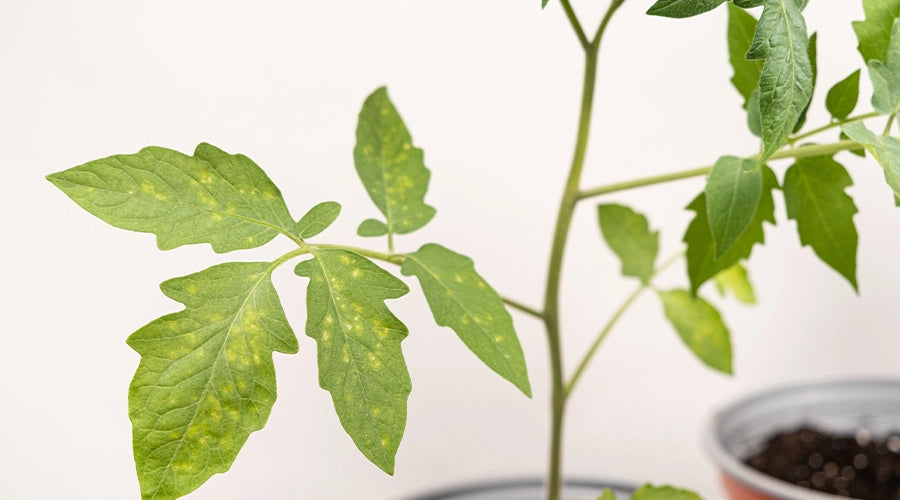
Cal-Mag Deficiency
Why is It Important to Plants?
Calcium (Ca) and magnesium (Mg) are two essential micronutrients that play vital roles in plant growth and development. These minerals are involved in various physiological processes, such as photosynthesis, root growth, and cell division. A shortage of either one of these minerals, or both, can lead to a deficiency in plants and result in stunted growth and reduced crop yields.

Calcium Deficiency
Calcium deficiency, also known as blossom-end rot, is a common problem that affects a wide range of crops, including tomatoes, peppers, and citrus fruits. This deficiency occurs when the plant is unable to absorb enough calcium from the soil, leading to the death of cells at the bottom of the fruit. The affected fruit becomes soft and mushy, resulting in a loss of quality and yield. Calcium deficiency is most commonly caused by soil pH levels that are too low or too high or soil moisture levels that are too high or too low.
Magnesium Deficiency
Magnesium deficiency, on the other hand, affects the chlorophyll in the leaves, leading to a yellowing of the leaf edges and a general yellowing of the entire leaf. The leaf eventually turns brown and dies, leading to reduced photosynthesis and a decrease in crop yields. Magnesium deficiency is most commonly seen in soils that are highly alkaline or in crops that are heavily fertilized with nitrogen.
How to Fix Cal Mag Deficiency
Both calcium and magnesium deficiencies can be prevented by providing the plants with proper soil conditions and adequate nutrient levels. This can be achieved by regularly monitoring soil pH levels, maintaining an appropriate soil moisture level, and applying the correct amount of fertilizers. In some cases, applying foliar sprays or adding lime to the soil can also help to correct these deficiencies.
Another factor that can contribute to calcium and magnesium deficiencies in plants is the availability of these minerals in the soil. In soils with low levels of these minerals, adding fertilizer is not enough to correct the deficiency. Instead, soil amendment with gypsum, dolomite lime, or magnesium sulfate may be necessary to raise the levels of these minerals in the soil.
It is also important to note that the uptake of calcium and magnesium by the plant can be influenced by other factors such as temperature, light intensity, and soil salinity. For example, high temperatures and high light intensity can reduce the availability of calcium in the soil, while high soil salinity can affect the uptake of both calcium and magnesium.
Moreover, the root system of the plant can also play a role in calcium and magnesium deficiencies. A weak root system, due to disease or other stress factors, can limit the plant's ability to absorb these minerals from the soil. In such cases, applying root boosters or improving the health of the root system can help to prevent these deficiencies.
It is also important to understand the interplay between calcium and magnesium in plants. While both minerals are essential for plant growth and development, an excess of one mineral can lead to a deficiency in the other. For example, an excess of calcium in the soil can reduce the availability of magnesium and vice versa. This is known as secondary nutrient antagonism and highlights the importance of maintaining a balanced ratio of these minerals in the soil.
In addition, the presence of other elements in the soil can also affect the availability of calcium and magnesium. For example, high levels of iron, aluminum, and manganese can reduce the availability of calcium in the soil, while high levels of potassium and sodium can reduce the availability of magnesium. Monitoring the levels of these elements in the soil and adjusting fertilizer application accordingly can help to prevent deficiencies.
Another important aspect to consider is the timing of fertilizer application. For example, applying calcium fertilizers at the wrong time can result in reduced uptake by the plant and a subsequent deficiency. Similarly, applying magnesium fertilizers at the wrong time can lead to leaching and reduced availability in the soil. It is important to understand the crop's nutrient uptake patterns and to apply fertilizers at the appropriate time to ensure proper uptake and utilization.
It is also important to consider the form of fertilizer applied. Calcium and magnesium are available in various forms, including nitrate, chloride, and sulfate, among others. Each form of fertilizer has its own benefits and drawbacks, and it is important to choose the appropriate form based on the needs of the crop and the soil conditions.
In conclusion, calcium and magnesium are critical elements for plant growth and development, and deficiencies of either mineral can have a significant impact on crop yield and quality. The interplay between these minerals, the influence of other elements in the soil, and the timing of fertilizer application are important factors to consider in preventing deficiencies. By following best practices for soil management and nutrient application, healthy and productive crops can be achieved.


